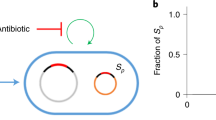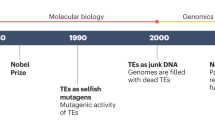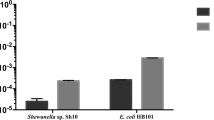Abstract
TRANSPOSONS are discrete sequences of DNA that are incapable of self-replication and can insert into DNA replicons, such as chromosomes or plasmids, in the absence of the recA gene function1. Insertion can be random and where it occurs into the continuity of a gene leads to non-leaky polar mutations1. Some transposons carry drug resistance genes and thus insertions can be mapped as drug-resistance markers1. We report here that Tn5, a transposon coding for kanamycin resistance2, can insert into the chromosome of Rhizobium leguminosarum, the bacterium responsible for nodulation and nitrogen fixation in Pisum, Vicia, Lathyrus and Lens.
This is a preview of subscription content, access via your institution
Access options
Subscribe to this journal
Receive 51 print issues and online access
$199.00 per year
only $3.90 per issue
Buy this article
- Purchase on Springer Link
- Instant access to full article PDF
Prices may be subject to local taxes which are calculated during checkout
Similar content being viewed by others
References
Kleckner, N., Roth, J. & Botstein, D. J. molec. Biol. 116, 125–159 (1977).
Berg, D. E., Davies, J., Allet, B. & Rochaix, J.-D. Proc. natn. Acad. Sci. U.S.A. 72, 3628–3632 (1975).
Datta, N., Hedges, R. W., Shaw, E. J., Sykes, R. B. & Richmond, M. H. J. Bact. 108, 1244–1249 (1971).
Olsen, R. H. & Shipley, P. J. Bact. 113, 772–780 (1973).
Beringer, J. E., Hoggan, S. A. & Johnston, A. W. B. J. gen. Microbiol. 104, 201–207 (1978).
Meade, H. M. & Signer, E. R. Proc. natn. Acad. Sci. U.S.A. 74, 2076–2078 (1977).
Kondorosi, A., Kiss, G. B., Forrai, T., Vincze, E. & Banfalvi, Z. Nature 268, 525–527 (1977).
Towner, K. J. & Vivian, A. J. gen. Microbiol. 101, 167–171 (1977).
Boucher, C., Bergeron, B., Barate de Bertalmio, M. & Dénarié, J. J. gen. Microbiol. 98, 253–263 (1977).
Van Vliet, F., Silva, B., van Montagu, M. & Schell, J. Plasmid (in the press).
Hernalsteens, J. P., De Greve, M., van Montagu, M. & Schell, J. Plasmid 1, 218–225 (1978).
Hirsch, P. R. thesis, Univ. East Anglia (1978).
Howe, M. M. & Bade, E. G. Science 190, 624–632 (1975).
Johnston, A. W. B., Beynon, J. L., Buchanan-Wollaston, V. A., Setchell, S. M., Hirsch, P. R. & Beringer, J. E. Nature, accompanying paper (1978).
Johnston, A. W. B. & Beringer, J. E. J. gen. Microbiol. 87, 343–350 (1975).
Johnston, A. W. B., Setchell, S. M. & Beringer, J. E. J. gen. Microbiol. 104, 209–218 (1978).
Ely, B. & Johnson, R. C. Genetics 87, 391–399 (1977).
Author information
Authors and Affiliations
Rights and permissions
About this article
Cite this article
BERINGER, J., BEYNON, J., BUCHANAN-WOLLASTON, A. et al. Transfer of the drug-resistance transposon Tn5 to Rhizobium. Nature 276, 633–634 (1978). https://doi.org/10.1038/276633a0
Received:
Accepted:
Issue Date:
DOI: https://doi.org/10.1038/276633a0
This article is cited by
-
Construction of a mariner-based transposon vector for use in insertion sequence mutagenesis in selected members of the Rhizobiaceae
BMC Microbiology (2014)
-
Pyruvate carboxylase is involved in metabolism of mimosine by Rhizobium sp. strain TAL1145
Archives of Microbiology (2008)
-
Auxotrophy in rhizobia revisited
Indian Journal of Microbiology (2007)
-
A histidine kinase sensor protein gene is necessary for induction of low pH tolerance in Sinorhizobium sp. strain BL3
Antonie van Leeuwenhoek (2006)
-
Heat Shock Tolerant Mutants of Rhizobium meliloti Forming Ineffective Nodules
Journal of Plant Biochemistry and Biotechnology (1995)
Comments
By submitting a comment you agree to abide by our Terms and Community Guidelines. If you find something abusive or that does not comply with our terms or guidelines please flag it as inappropriate.



